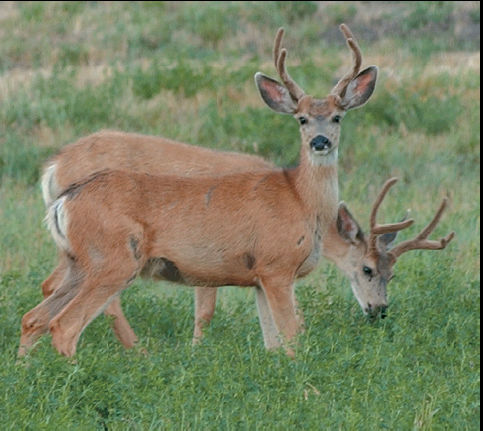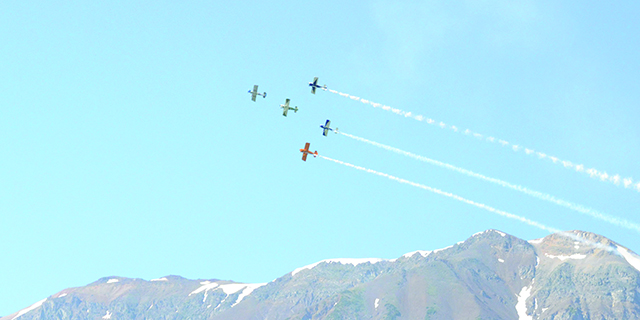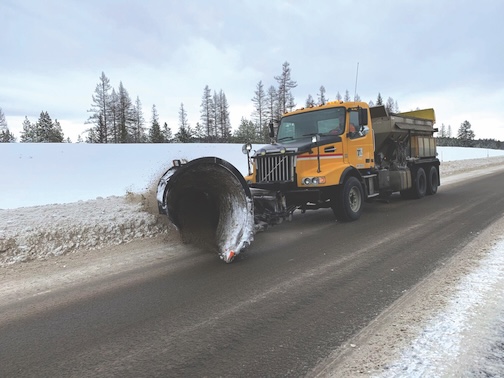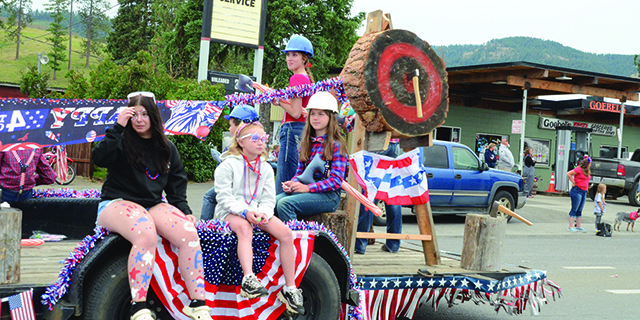FOG Wild game hunting forecast, northeastern Oregon
Published 6:00 am Monday, September 23, 2019

- <p>Mule and whitetail deer</p>
NORTHEAST AREA
Hunters may see a few more yearling bucks in the mix thanks to a mild winter and good over-winter survival. Early season hunters will be challenged by the dry conditions.
Trending
Beulah, Sumpter, Keating, Pine Creek, Lookout Mt. Wildlife Management units
Fire conditions are extreme and hunters should check with the land manager (Wallowa-Whitman National Forest or BLM) to find out the latest conditions, as they can change rapidly.
DEER
Over-winter survival was fair in all units with average fawn ratios of 29 per 100 adults counted in the spring. Heavy snow in late winter hurt fawn survival. Animals will be the most active early in the morning and late in the afternoon when temperatures cool off. Hunters should concentrate their efforts in areas of good forage near north slopes that provide good bedding cover.
The Beulah unit, is still recovering from the winter of 2016-17 with a fawn ratio of 24/100 adults. The buck ration is 14/100 does, which is just below the buck management objective of 15/100 does. As a result, tag numbers will remain at lower levels into the future to allow population to recover. With last year’s tag cuts, hunter success was 35 percent, which was down 10 percent from the previous year. There will be a few more yearling bucks available for harvest this year, but only a small increase.
ELK
Trending
Elk herds in Baker County came out of the winter in good shape. Bull ratios are at management objective for all units. Calf ratios were above the average in all units. Elk populations in the Keating, Pine Creek and Lookout Mountain units continue to grow and offer good opportunity for hunters.
For the best chance at tagging an elk, get as far away from roads as possible, perhaps by hunting in one of the cooperative Travel Management Areas. Dry conditions this year could make hunting difficult. Animals will be the most active early in the morning and late in the afternoon when temperatures cool off. Hunters should concentrate their efforts in areas of good forage near north slopes that provide good bedding cover.
BEAR and COUGAR
Bear and cougar hunting should be good this year. The fall season started off well with the office checking in several bears during the first week of the season. Huckleberry production was good this year. Hunt for bears in high elevation open areas with the most berries. Fall bear hunters have best success in higher elevation areas of the Keating and Pine Creek Units on the Wallowa Whitman National Forest.
Find cougars just about anywhere; remember to carry a tag.
Murderers Creek, Northside, Desolation Wildlife Management units
The Grant District experienced a harder than normal winter this past year, and deer populations saw declines as result of the winter conditions. Elk populations fared better as they are generally not as effected by weather but the calf ratios were slightly lower than normal.
The summer has been mild with some occasional rains so animals may be scattered as feed is wildly available and in larger than normal quantity.
DEER
Deer populations remain below management objectives in all units and declining after this winter. Buck ratios were at management objective in the Northside and Desolation units but above in Murderers Creek and Heppner units. Spring fawn ratios were a lower than desired, which is likely due to conditions last winter. The lower fawn ratio will cause a decrease in yearling bucks available for harvest this year.
Last year, archery and rifle hunters had average success for Northside and Desolation but above average for Murderers Creek. Lower success is expected this year.
Deer hunters should look for areas where fire has occurred in past 5-15 years as deer tend to favor vegetation that occurs following fires. The Shake Table Fire on Aldrich Mountain is starting to show signs of increasing deer and may be a good place to find a buck.
ELK
Hunting prospects are average for the district. Elk populations are steady in most of the district and above management objective in all units except West Beulah. We have had slightly lower calf ratios and good bull ratios in most of the district.
Elk hunters should focus on areas with no open roads as elk tend to move away from traveled roads during hunting seasons.
BEAR and COUGAR
Bear populations appear to be increasing slightly and hunting should be similar to past years. Look for bears around huckleberry patches in mid-August and our old orchards in mid-September. The fruit crop looks good this year because of adequate precipitation.
Cougar populations appear to be increasing and hunters are encouraged to have a tag while out hunting other big game, as that is when most cougar and bear harvest occurs. If using calls, remember cougars respond slower than coyotes so be prepared to spend more time.
Heppner, Fossil, East Biggs, southern Columbia Basin Wildlife Management units
DEER
Last year, deer populations in all of the units decreased due to the long dry summer and cold late winter. Fawn survival last year was poor and deer hunters will have a harder time finding yearling bucks this hunting season.
The summer has been fairly mild with decent forage conditions in the higher elevations and poorer conditions as you drop in elevation. Unless conditions change, early season hunters will want to focus on areas of good forage and water.
Public lands hunters in the Fossil unit have historically had better success in the Wheeler burn, but deer numbers and success rates in that area have decreased the last few years. Fossil unit hunters might look to other areas for better deer hunting this fall. Public land hunters can also hunt the Heppner Regulated Hunt Area in the Heppner unit.
The Columbia Basin is mostly all private land so hunters will need to secure access or hunt on some of the limited private land where ODFW has access agreements with the private landowners to allow public hunting access, such as the Open Fields access areas in the Columbia Basin unit.
ELK
The elk population in the Heppner unit is still slightly above management objective for the unit and the Fossil unit’s population is stable. Bull ratios have remained constant from last year for both units. The elk calf ratio for both units decreased slightly from last year but hunters should still find decent numbers of spike bulls. There are still good numbers of older age class bulls throughout the forest.
BEAR and COUGAR
Hunters are still seeing plenty of cougars in the Heppner district so there is opportunity for hunters to harvest an animal. The District has low densities of bears throughout the entire forested portion of the District, but you might see one when deer and elk hunting, so carry a tag.
Starkey, Catherine Creek, Mt. Emily, Sled Springs, and Wenaha Wildlife Management units
(The 2019 update for these units was not available at press time. For your information, we have included last year’s information below.)
DEER and ELK
Elk and deer numbers are stable throughout the Union County. Elk came through the winter well and calf survival is up. As a result, spike hunters can expect to see more yearling bulls this season. All units are at or above management objective for elk.
Deer numbers are stable, but are below management objective in all units. While deer numbers are still down, hunters may encounter more yearling bucks this season due to an increase in fawn survival over the winter.
Hunters can expect dry conditions in the early seasons that will keep animals closer to water sources such as springs and creek bottoms. Animals move little during warm conditions and hunters will need patience to be successful.
The Starkey Unit Travel Management Area is a great place to start for big game hunters new to the area; maps are available online or at the La Grande office. General spike season is a great time to elk hunt in the Starkey unit without the crowds of first season. Look for elk in the steep terrain of the Starkey and Catherine Creek units.
BEAR and COUGAR
Bear and cougar numbers are strong in all units. Cougar harvest has been down for the past few years but hunters still have a good chance of finding a cougar while calling or hunting for other big game. Look for cougar sign on ridge tops in areas of high elk use.
Bear harvest has been consistent over the past several years. Hawthorns are heavy with fruit heading into September. Look for bears in the creek bottoms and valleys, feeding on Hawthorn berries and other fruits. Road closure areas within the Catherine Creek and Starkey units will provide good walk-in access to bear habitat.
Wenaha, Sled Springs, Chesnimnus, Snake River, Minam, Imnaha Wildlife Management units
DEER and ELK
While mule deer populations are still low, white-tailed deer have had better fawn survival and buck season is expected to be fair in all units. Elk populations are doing well, and hunters can expect good prospects for bull hunting in all units. Deer populations are below MO in all units, while elk populations are above in all units except the Wenaha and Snake River.
Archery season is expected to be warm and dry as usual, making hunting conditions a little difficult. Archers in the Sled Springs unit need to be aware of motor vehicle restrictions and no camping restrictions on Hancock Timber property during fire season.
The district has not detected any drop in deer or elk populations as a result of wolf activity.
BEAR and COUGAR
Cougar and bear numbers are good throughout the district. Fall bear hunters should concentrate efforts around fruit orchards, and in draw and stream bottoms as bears will be using these areas feeding on berries. Cougar hunting is best sitting on a fresh cougar kill carcass, or calling with lots of patience.
Walla Walla, Mt. Emily, Ukiah, eastern portion of Heppner, northern Columbia Basin Wildlife Management units
DEER and ELK
Mule deer survival rates were good considering the harsh winter we experienced here in Umatilla County. However, mule deer numbers are below management objectives in all units. Buck ratios continue to be strong in all units and hunters can expect similar buck numbers to the previous two years.
Whitetail deer continue to expand in numbers and range across the district. Hunters will find very similar elk numbers to previous years. Overwinter survival was good with calf ratios remaining stable ranging from 16 to 20 calves in all three units. Both spike and branch bull hunters should expect good potential for this year’s hunts throughout the district.
With the heavy over winter snow pack and timely spring rains, forage conditions are abundant at mid and upper elevations. Due to an abundance of forage, hunters may find animals are more dispersed than in years past when they were concentrated near food sources. However, hunters should continue to focus on north facing slopes where good bedding areas are more prevalent. Also, until temperatures begin to drop later in the year, be sure to hunt around dawn and dusk when animals are more likely to be active.
BEAR AND COUGAR
Getting a spring bear tag in the Umatilla District is not easy, so the fall general season is your chance to hunt bear here. Bears are high up early in the season and will pull down slowly. Look in hawthorn and elderberry concentrations to find them; early on they will be on edges of clearings and clear-cuts near berry crops in high country. The best bear hunting is north of I-84 in Mt Emily and Walla Walla units.
Cougar populations are healthy; carry a tag while hunting deer or elk as you may get the chance to take a cougar while you’re at it. The best cougar hunting will be north of I-84 in the Mt. Emily and Walla Walla Units. The Ukiah Unit has a lower density of cougars than the two northern units, but has been increasing in density the last year or more. Still, hunters will have good chance of encountering a cougar there as well.
HUNTING LOCATIONS
Hunters without access to private land can use the Umatilla National Forest and ODFW’s Bridge Creek and Columbia Basin (Irrigon and Willow Creek) wildlife areas.









